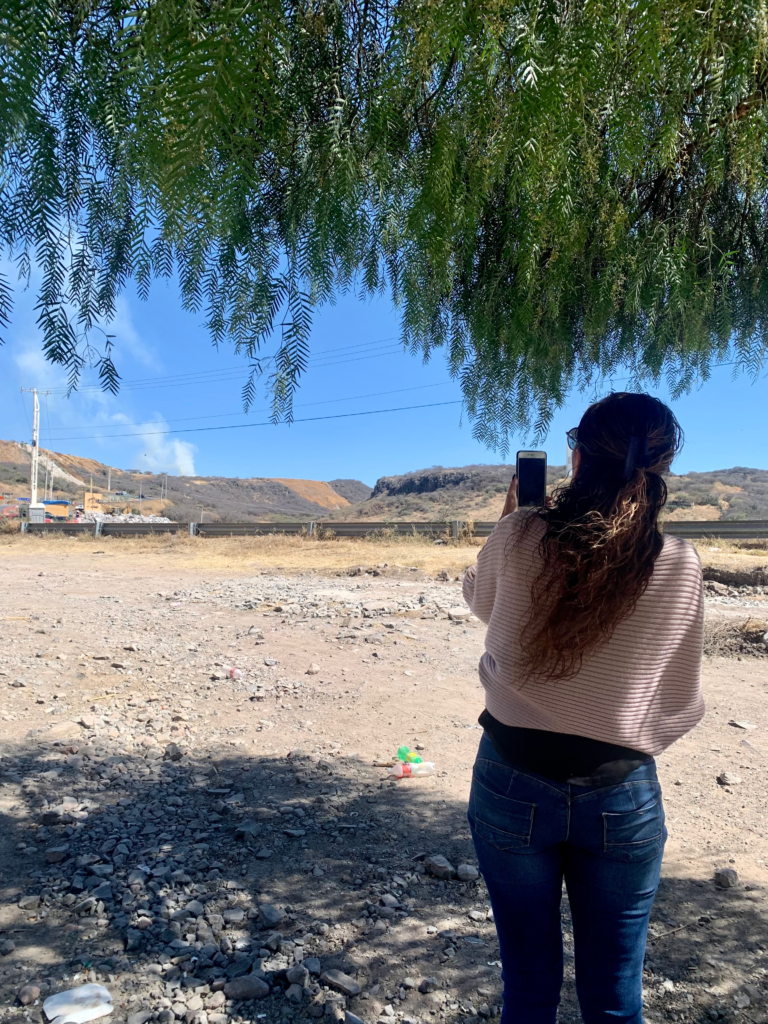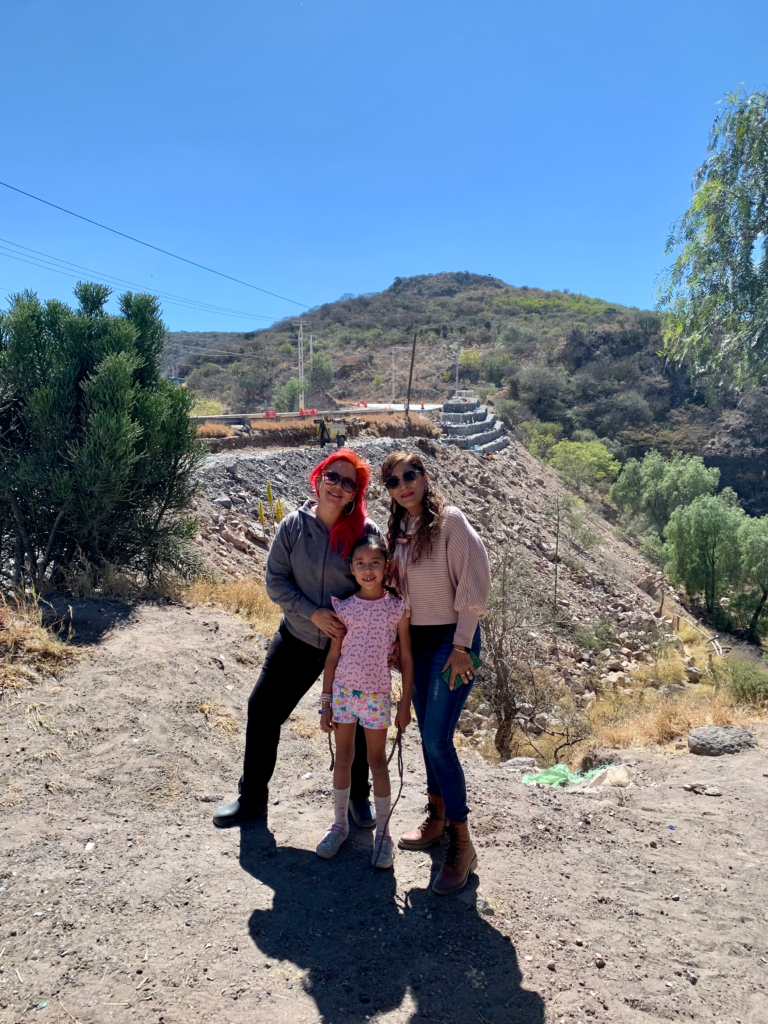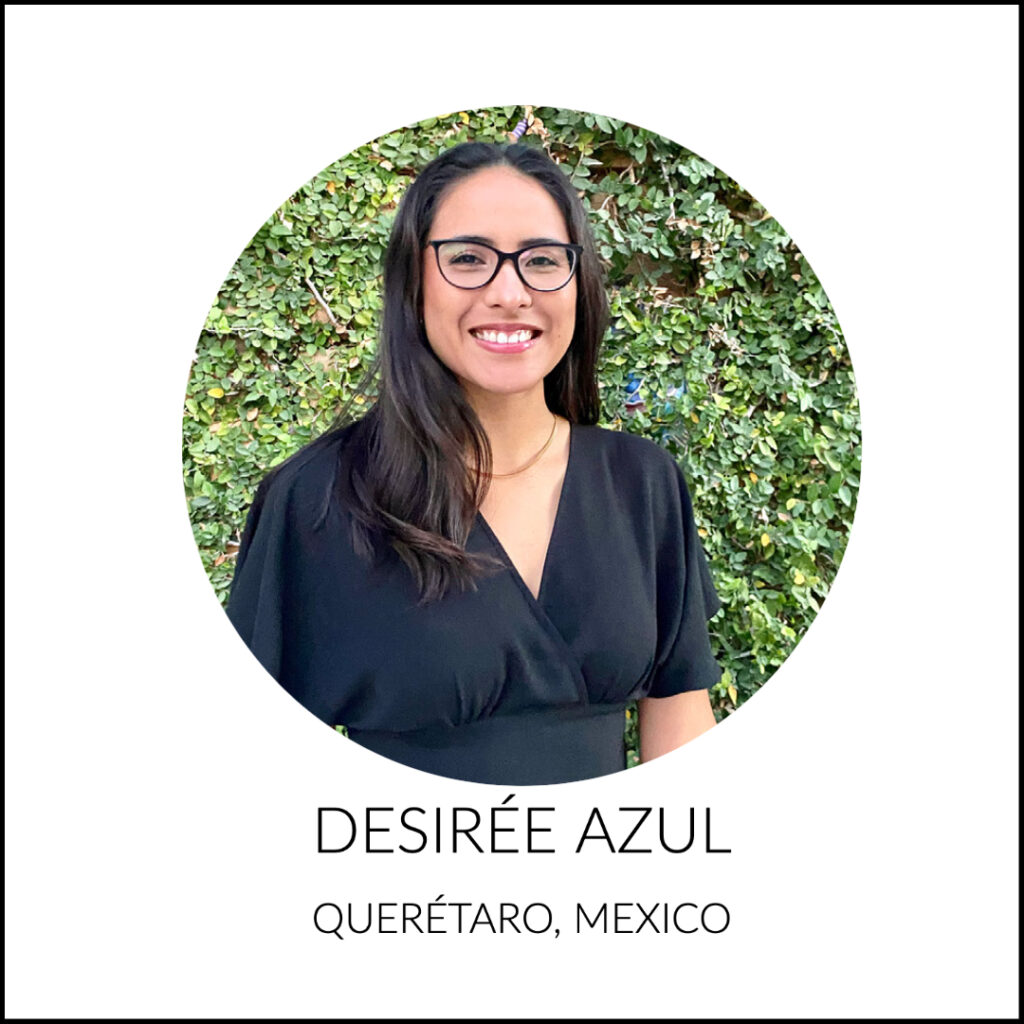Environmental Activism in Querétaro
by Desirée Azul
ENGLISH (with Spanish version below)
El Batán is a natural area protected by federal, state and municipal agencies, in Corregidora, Querétaro. The canyon offers a 7.9 km circular trail of vegetation with thousands of species endemic to the region.
The El Pueblito River flows through the canyon, but the growing construction of residential buildings in the area has altered the landscape.
Even so, El Batán is frequented by families on picnic days, people training for their next marathon, people looking to relax in the calm of nature, couples walking with their pets, and fathers taking their children on a bike ride.
We all have an obligation to leave the place we live in better shape than how we found it, to collaborate with each other. Each person should at least take care of and plant 10 trees. Use the water from rinsing clothes to water the trees in the avenues, it doesn’t even take 10 minutes.
Teresa Roldán
I met Teresa Roldán at the entrance of El Batán. Teresa is a citizen of the state of Querétaro and an environmental activist. She was accompanied by Andrea, a resident of the area. In the last months, they have been monitoring the construction of the 4-lane expansion of highway 413.
The construction is blocking access to the protected area and endangering the natural runoff of El Pueblito River. The construction work has already affected the trees at the entrance, burying them in sand or crushing them with the pass of heavy machinery.
For Teresa, nature is very important. She grew up in the foothills of Sierra de Guadalupe in the State of Mexico surrounded by trees and spring water. She remembers that when she had to take care of her seven siblings, she could find food in the foothills and not go hungry.
In 2017, she was part of a campaign to unify people to confront tree cutters during the construction of a shopping center and a road. “I got the support of both Pamela Siurob and América Vizcaíno, other important environmental activists. I had to confront the loggers many times asking them to show their permits to cut down trees. If you are going to cut down a tree, you must at least bring a permit. As citizens, we have an obligation to stop and ask why are you doing this?” “None of them ever showed me a permit, they would always back off, but eventually they ended up killing them. I managed to rescue five ash trees outside Walmart but they were transplanted in front of the construction site. You don’t transplant a tree like that. When you remove a tree, it requires a kind of intensive therapy. It’s like dismembering a person, putting that person in a bed and leaving him there. Who is going to recover like that? Those ash trees died despite the little care I could give them.”

Teresa transmitiendo en vivo el incendio
Photo: Desirée Azul
“85 to 90 trees were lost in the construction of the mall. It was a day and night struggle because the loggers took advantage of the situation to throw the trees out of sight of the activists, but we still went out at night and in the early morning. We managed to rescue 8 trees (mango trees, pirules and mesquites) that I now have under surveillance. I have them counted and I check them every time I pass by. The mango now gives a lot of freshness to the people who stop to buy coffee at Starbucks”.
The role of trees in the city is oxygen and life itself.
In my mind, the solution is to consider the vegetation of the site as part of the construction project but Teresa said that “what we want is that, before the municipality gives permits to developers, the environment gets evaluated first so the construction project can be planned based on the existing vegetation. But it is cheaper for the developer to pay the fine and cut down the trees than to include them in their planning. Another thing we are also looking for is to modify the norms because the state norm does not protect the trees, but actually leaves them very vulnerable”.
Teresa asked me to pause the conversation to broadcast live on Twitter and Facebook that a fire could be seen in the distance. At the end of her stream, she told me that she combines these activities with her work as a therapist, her home life and daily activities.
From demonstrations and unification of collectives to denunciations, visits to conflict zones and community assistance, she stresses that she does not work alone, because “the claims of many voices are better than the claims of one”.
Teresa Roldán along with Pamela Siurob attend to complaints from El Zapote, El Salitre, Peña Colorada, El Batán, Santa Bárbara, San Juan del Río, Huimilpan, Escolásticas, Amealco and Concá.
“Instead of protecting the health of citizens, we are losing our green zones. In all directions, you see housing areas are being constructed.
The role of trees in the city is oxygen and life itself. People see it as a nuisance but if there are trees there is water, if there is water there is food, there is life.
The more trees, the better the quality of life. The reforestation programs do not fulfill everything they should. They may look good in the photos, but in practice, they no longer comply”.
“You talk with Sedesu and they tell you it is Profepa responsibility, you talk Profepa and they say it is Pepmadu responsibility, you talk with Pepmadu and they say it is Conafor’s responsibility. Nobody really takes responsibility. Here in El Batán, neither the municipality nor Profepa have provided a solution.”

Teresa y Andrea con su hija, monitoreando la obra
Photo: Desirée Azul
During these six years of struggles between urban development and environmental protection, Teresa has spoken and kept the community interested in safeguarding nature through Facebook groups. One of them is called Árboles de Querétaro, NO A LA TALA! Voceros de la Madre Tierra (Trees of Querétaro, STOP THE FELLING! Spokespersons of Mother Earth).
I asked her about the response of the Queretaro community and she replied that “People come very impetuous, excited, eager with a video or a complaint, but after two months they get discouraged by the lack of response. Now there’s the issue with the state’s environmental code. Recently four laws in the code were repealed and the environment is now unprotected”.
“We all have an obligation to leave the place we live in better shape than how we found it, to collaborate with each other. Each person should at least take care of and plant 10 trees. Use the water from rinsing clothes to water the trees in the avenues, it doesn’t even take 10 minutes. On the way from the bus stop to your house, you can plant a tree and take care of it”.
With such a large problem and a constantly growing population, Teresa says that it is important to do what you say should be done, not just talk about it, but to put it into practice. Teresa personally cares for and protects several trees near her home.
Consistency and a government that leads by example are vitally important in this process. Teresa has attended the forums to create the state and municipal plan but she found out that “the government is giving water in plastic bottles, disposable cups, and plastic bags with fruit in the meetings”. “Governments should stop giving away eco-technologies because people don’t know what they are for and after a short time they are no longer useful due to lack of good use or maintenance. It would be better to use these resources to educate the citizens”.
We finished our conversation amidst the wind, the rising dust, and the noise of heavy trucks. In a hurry for the next activities of the day, we said goodbye to each other. Since then, Teresa has continued visiting El Batán and has organized citizen participation groups to spread the word and put more pressure on the state government. The struggle continues.
If you are interested in helping the cause, you can sign the petition that has been published on change.org. Remember that the more voices, the louder the noise.

Entrada a la reserva bloqueada por arena y árboles enterrados
Photo: Desirée Azul
Español
Activista por el medio ambiente
El Batán es un área natural protegida por varios organismos federales, estatales y municipales ubicada Corregidora, Querétaro. El cañón ofrece un sendero circular de 7,9 km de vegetación con miles de especies endémicas de la región. El río El Pueblito pasa por el cañón pero la creciente construcción de residenciales en la zona ha ido cambiando el panorama.
Aún así, el Batán es frecuentado por familias en un día de picnic, gente entrenando para su próximo maratón, personas buscando relajarse entre la calma de la naturaleza, parejas paseando con sus mascotas y papás con sus hijos en bicicleta.
Me reuní a la entrada de El Batán con Teresa Roldán, ciudadana del estado de Querétaro y activista por el medio ambiente. Estaba acompañada por Andrea, una vecina de la zona. En los últimos meses han estado monitoreando la construcción de la ampliación a 4 carriles de la carretera 413.
La obra tiene bloqueado el paso a los usuarios de la zona protegida y pone en riesgo la escorrentía natural del río El Pueblito. La obra ya ha impactado a los árboles de la entrada, dejándolos sepultados en arena o aplastados por el paso de la maquinaria pesada.
Para Teresa, la Naturaleza es muy importante. Ella creció en las faldas de la Sierra de Guadalupe en el Estado de México rodeada de árboles y agua de manantiales. Recuerda que al tener que hacerse cargo de sus siete hermanos podía encontrar comida en las faldas de la sierra y no pasar hambre.
En 2017 se dio a la tarea de volantear y unificar a la gente para enfrentar a los taladores de arbolado durante la construcción de un centro comercial y un eje vial. “Obtuve el apoyo tanto de Pamela Siurob y América Vizcaíno, otras importantes activistas del medio ambiente. Me tocó enfrentar muchas veces a los taladores pidiéndoles su permiso de tala. Si vas a talar un árbol, mínimo debes tener permiso. Como ciudadanos tenemos la obligación de detener el caminar y preguntar ¿Por qué lo estás haciendo?”. “Ninguno me mostró jamás un permiso, se retiraban, pero finalmente los terminaban por matar. Logré rescatar cinco fresnos a la salida de Walmart pero los trasplantaron a la parte de enfrente de la obra. Un árbol no se trasplanta ni lo avientas al otro lado. Cuando tú quitas un árbol, es una especie de terapia intensiva la que requiere. Es como desmembrar a una persona, conectarla a una cama y ahí abandonarla. ¿Quién va a recuperarse así? Esos fresnos se murieron a pesar del poco cuidado que yo les podía dar.”
“Se perdieron de 85 a 90 árboles en la construcción del centro comercial. Fue una lucha de día y noche porque los taladores aprovechaban para tirar los árboles fuera de los ojos de los defensores pero aún así salíamos en la noche y en la madrugada. Logramos rescatar 8 árboles (mango, pirules y mezquites) que ahora tengo vigilados. Están contados y los checo cada que paso. El mango ahora le da mucha frescura a la gente que se para a comprar café en Starbucks”
En mi mente, la solución es considerar a la vegetación del lugar como parte del proyecto de construcción pero Tere me responde “nosotros pedimos que antes de que el municipio les de permisos a los desarrolladores, se evalúe el entorno y en base a la vegetación existente se planee el desarrollo, pero al desarrollador le sale más barato pagar la multa y talar los árboles que incluirlos en su planeación. Otra cosa que estamos buscando también es que se modifiquen las normas porque la norma estatal no protege al arbolado, sino que lo deja muy vulnerable”
Teresa me pidió interrumpir la conversación para transmitir en vivo por twitter y facebook un incendio que se veía a los lejos. Al terminar su transmisión me platicó que estas actividades las combina con su trabajo de terapeuta, su hogar y actividades cotidianas, sin bajar la guardia.
Desde manifestaciones y unificación de colectivos hasta denuncias, visitas a zonas de conflicto y asistencia comunal. Recalca que no trabaja sola, pues “No es lo mismo que sean muchas voces a que sea una sola”.
Teresa Roldán junto con Pamela Siurob asisten denuncias de El Zapote, El Salitre, Peña Colorada, El Batán, Santa Bárbara, San Juan del Río, Huimilpan, Escolásticas, Amealco y rumbo a Concá.

El árbol de mango que Teresa y otros activistas lograron salvar
Photo: Desirée Azul
“En lugar de resguardar la salud de la ciudadanía, estamos perdiendo nuestro cinturón verde. Hacia todas direcciones hay desarrollo de zonas habitacionales.
El rol de los árboles en la ciudad es el oxígeno y la vida misma. La gente lo ve como algo estorboso pero si hay árboles hay agua, si hay agua hay comida, hay vida.
Entre más árboles mejor calidad de vida. Los programas de reforestación no cumplen con todo lo que deben. Son un programa de aparador o de foto pero en la práctica ya no cumplen”.
“Le dices a Sedesu y le toca a Profepa, le dices a Profepa y le toca a Pepmadu, le dices a Pepmadu y que le toca a Conafor. Realmente nadie se hace responsable. Ahora aquí en El Batán, ni Municipio ni Profepa han dado solución.”
Durante estos seis años de lucha en diferentes desafíos entre el desarrollo urbano y la protección ambiental, Teresa ha hablado y mantenido al tanto a la comunidad interesada en salvaguardar a la naturaleza a través de grupos en Facebook, uno de ellos es Árboles de Querétaro, NO A LA TALA! Voceros de la Madre Tierra.
Le pregunto sobre la respuesta de la comunidad queretana y me responde que “La gente llega muy impetuosa, emocionada, deseosa con un video o una denuncia, pero a los dos meses se desaniman por la falta de respuestas. Ahorita tenemos el código ambiental que rige al estado. Recientemente abrogaron cuatro leyes en el código y se desprotege al medio ambiente”
“Todos tenemos obligación de dejar el lugar que habitamos mejor que como lo encontramos, de colaborar entre todos. Por persona mínimo cuidar y plantar 10 árboles. Usar el agua del enjuague de la ropa para regar los árboles de las avenidas, no te toma ni 10 minutos. En el camino de la parada de autobús a tu casa puedes plantar un árbol y cuidarlo”.
Con una problemática tan grande y una población en constante crecimiento, Teresa sostiene que es importante hacer lo que dices que se debe de hacer, no solo hablarlo, sino llevarlo a la práctica. Teresa cuida y protege personalmente varios árboles cercanos a su domicilio.
La coherencia y el ejemplo por parte del gobierno son de vital importancia en este proceso. Teresa ha asistido a los foros para crear el plan estatal y municipal pero se encuentra con que “el gobierno está dando agua en botellas de plástico, vasos desechables, y bolsas plásticas con fruta”. “Los gobiernos deben dejar de regalar ecotecnias pues la gente no sabe para qué son y al poco tiempo ya no sirven por falta de buen uso o mantenimiento. Mejor que ese recurso lo ocupen en educar a la ciudadanía”.

Los árboles son vida
Photo: Desirée Azul
Terminamos nuestra conversación entre el viento, el polvo que se levantaba y el ruido de los camiones pesados. Apresuradas para las siguientes actividades del día, nos despedimos.
Desde entonces Teresa ha continuado con las visitas a El Batán y ha organizado grupos de participación ciudadana para difundir la información y ejercer más presión al gobierno del estado. La lucha continúa.
Si estás interesado en ayudar a la causa, puedes firmar en change.org la petición que se ha publicado. Recuerda que mientras más voces seamos, el ruido es más fuerte.

Desirée Azul has a background in Media & Communication and finds peace in nature. She has always daydreamed about a better world for both nature and humanity. Urbanism gave her hope and a sense of purpose towards working for better cities for people, community, and the environment.
Read Querétaro, Mexico Correspondent Desirée’s content here
Learn more about the Global Walkability Correspondents Network here

